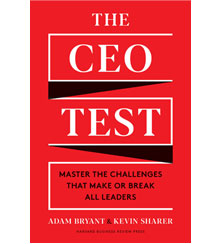Can you master the inner game of leadership?
Conflicting demands and challenges must be managed. Here’s how to do it.
A version of this article appeared in the Summer 2021 issue of strategy+business.
Niki Leondakis, a veteran hotel-industry CEO, started managing people in college when she was promoted from waiter to shift supervisor at a restaurant called the Hungry U near the University of Massachusetts. She took the job seriously, but in that role, as well as in her first management job out of college, she made a mistake common to many young leaders: She was too friendly with the people she was managing and had to learn the appropriate boundaries and necessary distance that managers have to keep from their teams. “I think people fall into one of two camps,” she said. “Very few people become a supervisor or a boss for the first time and know exactly where the right balance is. Both with myself and all the young managers I see, people seem to swing to one end of the pendulum or the other — overzealous with power or, ‘I’m everybody’s friend, and I want them to like me, and if they like me, maybe they’ll do what I ask and then it’ll be easier.’”
As she started advancing in her career, she adopted a more rigid and authoritarian style that she saw many men use, thinking that their approach was what successful leadership looked like. “That was in the early eighties,” she recalled. “For women in general at that time, we all thought that to be successful or to be considered equal, you tried to really dress like men, act like men, and ensure people knew you were tough-minded and could make the tough calls and be decisive.” But then a moment arrived when she recognized that she had swung the pendulum too far. She had to discipline someone on her team she liked and admired, and Leondakis’s boss could tell she was struggling with how to have the conversation. Her advice: Tap into who you are and relate to her with compassion.
“That was sort of an epiphany for me,” Leondakis said. “I thought that being tough-minded and decisive and all those qualities and traits that I thought I was supposed to exhibit meant that I couldn’t show compassion. It was just a different experience for me to relate to this person with compassion and accountability at the same time and balance the two. From that point on, I became aware that there was this balance I could strike with being myself, being compassionate, and holding people accountable. They were not mutually exclusive. Looking back, it took me a good 10 years before I really found my center and learned how to be true to my values.”
Though many people are loath to admit it, except to perhaps friends, family, and trusted confidants, leadership is hellishly difficult. Faced with the ever-shifting variables of leadership, people understandably latch on to one approach, telling themselves that they have developed their own leadership style and that others need to accommodate it. But anyone who goes into a leadership position with a brute-force, do-this-my-way style will soon be frustrated that the world is not bending to their will. Insecure in the shades of gray and contradictions of leadership, they harden their approach and become the terrible managers that everyone hates, because they don’t listen, they’re uncaring, and they’re short-tempered with anyone who doesn’t give them what they want. Their approach may work in certain situations, but not most, and they will quickly lose their most talented employees.
Then there are other leaders who seem preternaturally clear-eyed, calm, and confident. It’s not that they think they have all the answers; they often are the first to admit that they don’t. But as they describe their approach to leadership and key lessons learned, it becomes clear that, like Leondakis, they have spent many years working through different approaches to arrive at a balance point that resolves the core challenges of leadership, so that they understand what it means to be a leader.
James Hackett learned this important lesson when he took over as CEO of the office furniture company Steelcase at the young age of 39, the start of a nearly two-decade run in that role. During that time, he was widely credited with turning around the company’s corporate culture and spotting early the trend of shifting from cubicles to more open work environments. Shortly after becoming CEO, he was introduced to Bill Marriott, whose tenure as CEO of Marriott International ultimately spanned four decades.
Hackett, who later ran Ford Motor Company for three years, recalled: “As we were talking about strategy, I remember being struck by the look in his eyes as he talked. I understood in that moment that he knew who he was. I wanted to have that quality as a leader, where it’s really clear who you are and what you stand for. What does a CEO look like and feel like? What’s the texture of what you’re supposed to be? Since then, I’ve met just about every CEO who runs a big company. The ones I’m most impressed with do not seem packaged. They have this sense of peace, this self-awareness, that says, ‘I understand who I am.’”
What does it take to reach that level of comfort and self-awareness? Experience is the best teacher, of course. But our overarching framework to mastering the inner game of leadership is to embrace leadership as a series of paradoxes. It’s the first step to making sense of all the whiplash-inducing advice you will find in this field.
Our overarching framework to mastering the inner game of leadership is to embrace leadership as a series of paradoxes. It’s the first step to making sense of all the whiplash-inducing advice.
For every expert who urges you to “lead from the front,” you can find another who insists that the best approach is to “lead from behind.” Or that confidence is key — “Never let them see you sweat” — except when you should be vulnerable. When taking on a new leadership role, many argue, you should make quick decisions to show urgency and impact. Others counsel patience, so you can listen and really understand the root issues. The danger lies in slavishly following any one-size-fits-all approach. It’s better to understand that the thorniest aspects of leadership are hard because they are paradoxical. Is it this or is it that? The answer is often both. What’s needed is to flex one way or the other depending on the subtleties of the situation. Every one-on-one interaction, every team meeting, requires a different approach to suit the moment, whether it’s to push or hang back, to be demanding or understanding, to project brash optimism or acknowledge sobering challenges. Such moments, in a sense, are like skiing — you have to know the balance point, and constantly adjust and lean in different directions as conditions and terrains require.
Here are seven paradoxes that are hallmarks of a leader’s life and must be mastered to improve your chances of making good decisions and effectively leading the people who are relying on you.
Be confident and humble
As a leader, you have to have a clear vision, because the organization and all its stakeholders need you to inspire confidence. And confidence, in its healthiest manifestation of being authentic and credible, stems from a track record of demonstrating good judgment and engendering confidence in others. However, confidence cannot be allowed to morph into arrogance, and the best safeguard is humility — acknowledging to your team that any ambitious effort is going to be difficult and will carry risks and the possibility of failure.
“One problem is people who are always overly optimistic and overconfident,” said John W. Rogers Jr., the founder and co-CEO of Ariel Investments. “You want people who are appropriately humble, open to explaining their mistakes, and not always creating the sense that they have all the answers. You want people who are open and honest about their strengths and their weaknesses personally, and the strengths and weaknesses of the organization, and are not always seeing everything through rose-colored glasses.”
Be urgent and patient
Leaders who understand this paradox spend their time in ways that reflect the balancing act between now, soon, and later. It requires continuous fine-tuning of speed and being able to live with the fact that you will get it right one day and wrong the next. It means recognizing the need to slow down, bring people along by sharing context and rationales, and make sure there are proper processes and resources in place, even if you as the leader are feeling the weight of the world to achieve some target quickly. Move too slowly, however, and a competitor will blow past you.
“Your strength can really be a weakness at some point in your career,” said Carla Cooper, the former CEO of Daymon Worldwide, a retail consultancy. “I embraced this idea of getting things done through other people and figuring out how to counsel associates so that they can motivate themselves, but it takes a lot of time and patience. So my patience is seen sometimes as being not aggressive or forceful enough about telling the team what to do. I constantly struggle with the balance of being patient and saying, ‘Here’s the mountain, here’s where we’re going, here’s what I need you to do, and here’s why I need you to do it.’ The balance is where the magic is.”
Be compassionate and demanding
Leaders often set a high bar for their people. But those demands for exceptional performance have to be balanced with a sense of compassion and the understanding that their team is made up of human beings. People do their best work when they are treated more like volunteers than mercenaries. Everybody is struggling with something in their lives — an ailing parent, a child having difficulties at school, a marriage under strain — and there are moments when understanding and appreciation are more important than a tough conversation about meeting next quarter’s target. Compassion isn’t about being soft; it’s about acknowledging that we are all human. The tricky balance for leaders is to know when to push and when to be empathic.
Lucien Alziari, the chief human resources officer at Prudential Financial, captures this paradox in an approach he uses to give feedback to his team. “I tell them right up front, ‘Look, I grew up with tough love and you’re going to experience tough love,’” Alziari said. “It’s really important that you remember both sides of that phrase, because if you’re just experiencing tough, it’s going to feel like the dark side of the moon. But know that I’ve got your best interest at heart, and the only reason I’m doing this is because I believe in you, and I want you to be even better than you are.”
Be optimistic and realistic
Leaders are expected to be optimistic and to build energy, enthusiasm, and passion for the ambitious goals that they’ve laid out for the organization. The balancing act for leaders is to share the risks, build contingency plans, and put everyone on high alert that the plan may not play out as expected, yet also create a wide landing zone for success. How transparent should you be about the business challenges you’re facing? You want to keep people inspired and focused on the long-term goal, but if you share too many of the storm clouds, people may start thinking they should look for another job. On the other hand, your staff shouldn’t be blindsided by bad news, and sharing a challenge will invite them in to help. The best approach is to let people know about the big challenges (ideally paired with a plan for addressing them) while not overwhelming them.
Chris Barbin, the former CEO of Appirio, an information technology company, said: “I don’t think a lot of leaders are great at true transparency. Transparency can mean, if things aren’t going well financially, just being blunt and direct about it. The only way a team can get out of a jam or a negative environment is by being very transparent. Call it a red light. Don’t call it yellow or green, but call it red when it’s red and have everyone row against that new goal. There is a lot more upside to being open and honest and sharing everything than the downside associated with hiding and masking it. The upside is that you build a level of trust and respect and support. To think that everything’s perfect and up and to the right all the time for everybody is just not true. There’s way too much happy talk in business, but then on Day One of the next quarter, there are layoffs and cuts, which creates a whipsaw effect where you blow up trust and respect and loyalty very quickly.”
Read the weather and set it
Successful leaders develop a system for listening to learn what people are thinking and saying at all levels of the organization. It is the skill of reading a room at an organization-wide level and being able to pick up on the nonverbal cues of body language to understand the subtle emotions at play. CEOs need to be able to sense the mood — to, in effect, “read the weather” — in meetings or as they walk the hallways or visit stores and factory floors. Yet leaders must also recognize that they play an outsized role in setting the weather, because they establish the tone through their body language and energy.
For example, Lisa Falzone, the CEO of Athena Security, learned that she had to pay attention to employee morale, but couldn’t let it guide her. “You always have to be focused on the vision and what you’re trying to accomplish, because if you focus too much on what’s going on around you in the moment, sometimes it can tear you off your course,” she said. “You always want to have composure in front of your employees. They can tell if you’re stressed, and then they feed off that. So if I’m ever stressed, either I try to not show it to my employees, or I go work in my office for a little while. I didn’t realize this so much when I started, but everything stems from you.”
Create freedom and structure
The nature of a leader’s work is going to affect the balance of this paradox. In some areas, such as running nuclear power plants and performing surgery, the margin for error is incredibly low, and the culture is necessarily less about freedom and more about structure, more about safety and compliance than creativity and improvisation. In others, like advertising or television, there is much greater need for new ideas, which emerge only if there is a certain amount of chaos. Big companies may have a mix of both, with more of a process-driven manufacturing arm and a marketing department that demands fresh thinking. For leaders, that means allowing for some work that may appear unproductive, with side trips down blind alleys and seemingly unproductive brainstorming. The challenge is knowing when to let the conversation unfold and knowing when to step in to redirect the discussion.
Marjorie Kaplan, the former president of global content for Discovery Inc., said: “Organizations have a tendency to be self-censoring, always moving forward and making decisions at the exclusion of a kind of tolerance for confusion that I think you need for creativity. You don’t want a confused organization all the time. But you can’t have an orderly organization all the time, either. Real creativity comes from the ability to tolerate the confusion and to be able, in the right moment, to land the decision and then move forward with that decision in a structured way. My ability to tolerate confusion has grown. Creativity is frightening and messy. You’re not going to get a big, game-changing idea from trying to do what you’re doing now, but just a little bit better. You must find a way to try ideas that don’t seem like they make any sense, to let certain people just go spiraling off for a while, because that’s their process. And then decide when it’s time to reel them in.”
Be selfless and focus on your well-being
Now for the final paradox: The very best leaders are selfless — it is not about you, but rather what you can do for the people you lead and for your organization. Yet if you aspire to be that selfless leader, then you must learn to take care of yourself first; otherwise, your physical and emotional energy will be compromised, limiting your ability to help others.
Many factors beyond your control, like luck, timing, and personal chemistry, may keep you from achieving the title you want. What is within your control, however, is how you will lead others.
Winning the inner game means answering the following questions, among others: How do you manage your ego, which the trappings of leadership have a way of inflating, so that you don’t become overly confident and start communicating in ways that are off-putting to people? How do you handle all of the stresses from the endless demands, the weight of expectations, and the consequences of your decisions? How do you remain calm on the outside when you may be in turmoil on the inside? Where do you get the stamina to be your very best, in every encounter, through days of back-to-back meetings with different groups, all of which have outsized expectations of you? How do you make time for yourself so you can reflect beyond the demands and pressures of today to peer over the horizon? How do you nourish yourself in some intellectual or cultural way so that you can feel inspired, to better inspire others? How do you find someone who has no other agenda than to help you and can be a trusted sounding board for your ideas and is willing to simply listen to you vent? How do you take care of your health?
While these pressures are particularly magnified for CEOs, every person in a leadership role experiences them to some degree. By understanding how chief executives navigate the most critical challenges they face, we believe everybody can be a more effective leader, regardless of their title. Many factors beyond your control, like luck, timing, and personal chemistry, may keep you from achieving the title you want. What is within your control, however, is how you will lead others. Ultimately, that is defined by your choices, not the choices of others, and how you would answer the following questions in those quiet moments when it’s just you and the person in the mirror:
• What values are bedrock for you and will never be compromised, regardless of the challenges you face?
• Will you see the people who report to you as assets to help you achieve your goals, or will you see your role as unlocking skills and talents that they may not see in themselves?
• Are you able to embrace all the demands and paradoxes of leadership and recognize that you must be intensely self-aware and see growth as a lifelong journey?
• Are you willing to take full accountability for results, always strive for improvement, and not instinctively blame others when you miss the mark?
• Do you understand that trust is binary and that people either trust you or don’t, based on how you act at every moment?
• Do you have the guts and wisdom to make tough and unpopular calls?
• If employees could choose their managers and leaders, would they choose you? And if so, why?
• Do you understand that, despite all the attention leaders get the higher up they go, ultimately it’s not about you?
This realization is the final CEO test, the one that will determine whether you succeed, on the terms that only you can set for yourself, in becoming the leader you want to be.
Author profiles:
- Adam Bryant is managing director of Merryck & Co., a senior-leadership development firm. He is the author, with Kevin Sharer, of The CEO Test: Master the Challenges That Make or Break All Leaders.
- Kevin Sharer is the former CEO of Amgen, one of the largest biotech companies in the world. After leaving the role in 2012, he joined the faculty of Harvard Business School, where he teaches strategy and management.
- Adapted from The CEO Test: Master the Challenges That Make or Break All Leaders, by Adam Bryant and Kevin Sharer, published on March 2, 2021. Reprinted by permission of Harvard Business Review Press. Copyright © 2021 Adam Bryant. All rights reserved.





